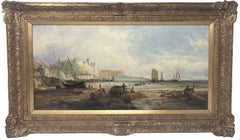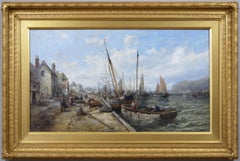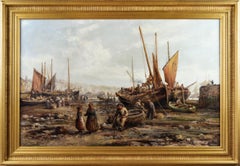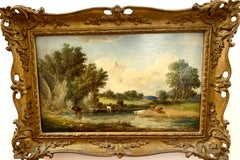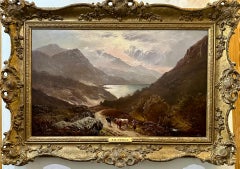William Edward Webb Art
to
3
3
3
1
2
Overall Height
to
Overall Width
to
1
2
2
1
3
3
6,938
3,292
2,514
1,213
3
3
2
2
Artist: William Edward Webb
Hastings Castle oil painting seascape 19th century, William Edward Webb
By William Edward Webb
Located in York, GB
Hastings Castle from the beach oil William Edward Webb
A fine 19th century oil on canvas painting depicting Hastings Castle from the beach with fishermen and boats
housed in a git ...
Category
19th Century Old Masters William Edward Webb Art
Materials
Oil
19th Century seascape oil painting of Douglas Harbour, Isle of Man
By William Edward Webb
Located in Nr Broadway, Worcestershire
William Edward Webb
British, (1862-1903)
Douglas Harbour, Isle of Man
Oil on canvas, signed
Image size: 21.5 inches x 37.5 inches
Size including frame: 33 inches x 49 inches
A busy quayside painting by William Edward Webb of Douglas Harbour on the Isle of man. Fishermen in boats can be seen preparing to head ashore as other figures make their way along the quayside.
William Edward Webb was born in Cheltenham, Gloucestershire in 1862 to William Benjamin Webb and Ellen Butler. His father was a printer and an artist and it is highly likely he received tuition from him. Following the death of his mother, his father remarried and moved the family to Manchester sometime after 1871.
By the 1880’s, Webb had started working as an artist and later set up a studio at 30 Exchange Buildings in Manchester. He began exhibiting at the Manchester City Art Gallery from 1890, where he showed more than 60 paintings during his lifetime. He also exhibited at the Royal Academy and Walker Art Gallery Liverpool from 1892. He married Clara Foster in 1899 and the couple lived at 1 Sylvan Grove, Chorlton Upon Medlock in South Manchester with their daughter Florrie. He became friends with the artist Walter Emsley (1860-1938) who also lived in Manchester.
Although he spent the rest of his life in Manchester, Webb travelled throughout the UK painting coastal and marine scenes around the main ports and harbours. He spent a great deal of time in the Isle of Mann painting numerous scenes along the coast including views of Peel and Douglas Harbour, subjects he frequently returned to. Webb painted in a highly distinctive style; loose and informal but which manages to retain the sense of perspective. He struggled with ill health and depression throughout his life which sadly led to his suicide 9 November, 1903. In 1974, a retrospective exhibition was held at The Old Customs House and Old Solent House in Lymington, which brought a new found interest in his work.
His paintings are now highly sought after and are represented in many collections and Museums including the Astley Hall...
Category
19th Century Victorian William Edward Webb Art
Materials
Canvas, Oil
19th Century seascape oil painting of Penzance harbour, Cornwall
By William Edward Webb
Located in Nr Broadway, Worcestershire
William Edward Webb
British, (1862-1903)
Penzance Harbour
Oil on canvas, signed
Image size: 29 inches x 45.5 inches
Size including frame: 38 inches x 54.5 inches
A pleasing coastal painting of Penzance Harbour at low tide by William Edward Webb. In the foreground, a fisherman sells his catch to a woman and her daughter, whilst figures in horses and carts wait for others to unload their boats.
William Edward Webb was born in Cheltenham, Gloucestershire in 1862 to William Benjamin Webb and Ellen Butler. His father was a printer and an artist and it is highly likely he received tuition from him. Following the death of his mother, his father remarried and moved the family to Manchester sometime after 1871.
By the 1880’s, Webb had started working as an artist and later set up a studio at 30 Exchange Buildings in Manchester. He began exhibiting at the Manchester City Art Gallery from 1890, where he showed more than 60 paintings during his lifetime. He also exhibited at the Royal Academy and Walker Art Gallery Liverpool from 1892. He married Clara Foster in 1899 and the couple lived at 1 Sylvan Grove, Chorlton Upon Medlock in South Manchester with their daughter Florrie. He became friends with the artist Walter Emsley (1860-1938) who also lived in Manchester.
Although he spent the rest of his life in Manchester, Webb travelled throughout the UK painting coastal and marine scenes around the main ports and harbours. He spent a great deal of time in the Isle of Mann painting numerous scenes along the coast including views of Peel and Douglas Harbour, subjects he frequently returned to. Webb painted in a highly distinctive style; loose and informal but which manages to retain the sense of perspective. He struggled with ill health and depression throughout his life which sadly led to his suicide 9 November, 1903. In 1974, a retrospective exhibition was held at The Old Customs House and Old Solent House in Lymington, which brought a new found interest in his work.
His paintings are now highly sought after and are represented in many collections and Museums including the Astley Hall...
Category
19th Century Victorian William Edward Webb Art
Materials
Oil, Canvas
Related Items
19th century English Antique oil landscape with cows resting by a river
By Alfred Vickers
Located in Woodbury, CT
A stunning 19th century English Antique oil landscape with cows resting by a river.
Alfred Vickers was a painter of marine subjects and landscapes. He exhibited extensively througho...
Category
1860s Victorian William Edward Webb Art
Materials
Oil, Canvas
Free Shipping
H 14 in W 18 in
Scottish 19th century Highland landscape, with a figure and cattle on a pathway
By Sidney Richard Percy
Located in Woodbury, CT
Wonderful Scottish 19th century Highland landscape, with a figure and cattle on a pathway overlooking a Loch
This piece is signed lower right and is framed in a Vintage Gold Leaf fr...
Category
1850s Victorian William Edward Webb Art
Materials
Canvas, Oil
Free Shipping
H 17 in W 23 in
Antique Dutch 19th century ships at sea, fishing boats, men rowing.
Located in Woodbury, CT
A very well-painted Dutch 19th century marine scene. The small boat is full of men who are rowing hard to get to the larger vessels, possibly to either take goods on or off the large...
Category
1870s Victorian William Edward Webb Art
Materials
Oil, Canvas
Free Shipping
H 16 in W 19.5 in
19th Century Roman Landscape oil on canvas with Giltwood Frame
Located in Rome, IT
Amaizing 19' century Roman landscape depicting a part of Villa Borghese with Trinità dei Monti.
With a finely carved gilt wood coeval frame.
Measurements with frame cm 65 x78 wit...
Category
19th Century Old Masters William Edward Webb Art
Materials
Oil
Antique Scottish Highland Loch landscape, with sunlit streaming onto the water
By Francis E. Jamieson
Located in Woodbury, CT
Francis Jamieson was a painter in oil and watercolor of highland landscapes and coastal scenes. (The work of this highly prolific artist is curious since the oils and watercolors have two quite distinctive styles and subject matter. The oil paintings are most frequently seen and these are highland landscapes or loch scenes - sometimes they appear to be signed with pseudonyms such as 'W. Richards' and 'Phil Hips' - the location is usually inscribed on the reverse. The watercolors are often coastal scenes with boats and figures on a shore, painted in a more traditional Victorian style, and possibly pre-date the oils. F. E. Jamiesons's beach scenes were published as postcards around 1920 by G. Ajelli & Co. of London on a textured card to give the appearance of oils.
Jamieson is known to have traveled widely in the South of England between the wars selling his work but does not appear to have exhibited.) This quote in parentheses is taken from Jeremy Wood's excellent book 'Hidden Talents - A Dictionary of Neglected Artists Working 1880-1950'.
-
Work by Francis Jamieson can be seen at the usual sites. Please note that on all these sites you will find F. E. Jamieson variously listed as Francis E. Jamieson, F.E.Jamieson, Frank E. Jamieson, Frederick E. Jamieson etc. You may also find some listings under his various pseudonyms of Arnould Pienne, Charles Maurice, Graham Williams...
Category
1910s Victorian William Edward Webb Art
Materials
Canvas, Oil
Free Shipping
H 21 in W 29 in
19th century English marine Sailing scene of Dutch fishing boats by a harbor
By Henry King Taylor
Located in Woodbury, CT
Henry King Taylor was a marine and coastal scene painter who lived in London. He exhibited at the Royal Academy from 1859 to 1864 with titles includi...
Category
1850s Victorian William Edward Webb Art
Materials
Canvas, Oil
Henry King Taylor19th century English marine Sailing scene of Dutch fishing boats by a harbor , 1859
Free Shipping
H 21 in W 33 in
Antique Breton Fishing Scene French Oil Painting on Canvas Fishermen & Women
Located in Cirencester, Gloucestershire
Breton Fisherfolk on the Shore
French School, early 1900's
signed with initials HB
oil on canvas, unframed
canvas: 15.5 x 20 inches
provenance: private collection, France
condition: ...
Category
Early 20th Century Victorian William Edward Webb Art
Materials
Oil, Canvas
View of Shipping on the River Avon from Durdham Down, near Bristol
Located in Stoke, Hampshire
Thomas Smith of Derby (c. 1710-1767)
View of Shipping on the River Avon from Durdham Down, near Bristol, 1756
Oil on canvas
Canvas size - 20 x 47 in
Framed size - 26 x 53 in
Provena...
Category
18th Century Old Masters William Edward Webb Art
Materials
Oil
Antique oil on canvas, English landscape with River, Church, Cottage at Sunrise
By Daniel Sherrin
Located in Woodbury, CT
Well-painted English late 19th century RIver landscape, with river, Church Cottage at Sunrise
Daniel Sherrin 1868-1940 signed L. Richards This is a framed original oil painting on c...
Category
Early 1900s Victorian William Edward Webb Art
Materials
Canvas, Oil
Free Shipping
H 27 in W 37 in
19th century Antique English Victorian Summer Harvest landscape, with figures.
By John Mundell
Located in Woodbury, CT
19th century English Antique Victorian Summertime Harvest landscape, with figures.
John Mundell was a British painter of landscapes as well as river scenes and coastal views. It is suggested that Mundell was a pseudonym of John James Wilson. Mundell’s work was vigorous, bright, and attractive and compares favorably with the work of many of the better artists of his time.
This is a very fine example of the artist's work. It is a rare composition for the artist as he mostly painted marines.
This piece is framed in its original antique gold leaf frame
Category
1870s Victorian William Edward Webb Art
Materials
Canvas, Oil
Free Shipping
H 17 in W 25.5 in D 3 in
English 19thC Victorian Shipping scene with fishing boats in the English Channel
By William Anslow Thornley
Located in Woodbury, CT
William Thornley was a painter of coastal scenes whose work is very similar to Hubert and Charles Thornley, who may have been members of the same family. He painted scenes of genre, architecture and landscapes as well. A number of the landscapes were of Belgium, Holland, Italy and Norway. However, it is for his seascapes that he is best remembered.
Thornley’s works are beautifully detailed and show a masterful understanding of the moods of both weather and sea. They are often small in size and put together with fine detail and great artistic merit. Thornley’s fishing scenes are spirited and similar in style to those of “Jock” Wilson, and are often painted in pairs. Thornley’s works have always been popular when they appear on the art market.
He was believed to have first exhibited marines at the Royal Academy in 1859 from an address in Paddington, London and also at the British Institution from 1861 until it closed in 1867. He continued to exhibit at the Royal Academy until 1898.
Thornley also exhibited at the Paris Salon and the Salon of French Artists, receiving an honourable mention in 1881 and a third place medal in 1888.
William Thornley also went by the names Georges William and William...
Category
1870s Victorian William Edward Webb Art
Materials
Oil, Canvas
Early oil depicting the Great Fire of London
Located in London, GB
The Great Fire of London in September 1666 was one of the greatest disasters in the city’s history. The City, with its wooden houses crowded together in narrow streets, was a natural fire risk, and predictions that London would burn down became a shocking reality. The fire began in a bakery in Pudding Lane, an area near the Thames teeming with warehouses and shops full of flammable materials, such as timber, oil, coal, pitch and turpentine. Inevitably the fire spread rapidly from this area into the City. Our painting depicts the impact of the fire on those who were caught in it and creates a very dramatic impression of what the fire was like. Closer inspection reveals a scene of chaos and panic with people running out of the gates. It shows Cripplegate in the north of the City, with St Giles without Cripplegate to its left, in flames (on the site of the present day Barbican). The painting probably represents the fire on the night of Tuesday 4 September, when four-fifths of the City was burning at once, including St Paul's Cathedral. Old St Paul’s can be seen to the right of the canvas, the medieval church with its thick stone walls, was considered a place of safety, but the building was covered in wooden scaffolding as it was in the midst of being restored by the then little known architect, Christopher Wren and caught fire. Our painting seems to depict a specific moment on the Tuesday night when the lead on St Paul’s caught fire and, as the diarist John Evelyn described: ‘the stones of Paul’s flew like grenades, the melting lead running down the streets in a stream and the very pavements glowing with the firey redness, so as no horse, nor man, was able to tread on them.’
Although the loss of life was minimal, some accounts record only sixteen perished, the magnitude of the property loss was shocking – some four hundred and thirty acres, about eighty per cent of the City proper was destroyed, including over thirteen thousand houses, eighty-nine churches, and fifty-two Guild Halls. Thousands were homeless and financially ruined. The Great Fire, and the subsequent fire of 1676, which destroyed over six hundred houses south of the Thames, changed the appearance of London forever. The one constructive outcome of the Great Fire was that the plague, which had devastated the population of London since 1665, diminished greatly, due to the mass death of the plague-carrying rats in the blaze.
The fire was widely reported in eyewitness accounts, newspapers, letters and diaries. Samuel Pepys recorded climbing the steeple of Barking Church from which he viewed the destroyed City: ‘the saddest sight of desolation that I ever saw.’ There was an official enquiry into the causes of the fire, petitions to the King and Lord Mayor to rebuild, new legislation and building Acts. Naturally, the fire became a dramatic and extremely popular subject for painters and engravers. A group of works relatively closely related to the present picture have been traditionally ascribed to Jan Griffier...
Category
17th Century Old Masters William Edward Webb Art
Materials
Canvas, Oil
Previously Available Items
On the Coast of Holland
By William Edward Webb
Located in London, GB
William Edward Webb (1862-1903)
On the Coast of Holland
Signed 'W.E. Webb' and dated '1876'
oil on canvas
12.5 x 17.5 inches, inc. frame
A success story nearly 100 years in the maki...
Category
Late 19th Century Post-Impressionist William Edward Webb Art
Materials
Oil
Chestnut Mare in a stable
By William Edward Webb
Located in Woodbury, CT
William Edward Webb
English sporting painter from the early to middle period of the 19th century.
Webb was a specialist in horse portraits and his work is close to the paintings of...
Category
Mid-19th Century William Edward Webb Art
Materials
Oil
Market Day in a Coastal Town, oil on canvas
By William Edward Webb
Located in Nr Broadway, Worcestershire
William Edward Webb
British, (1862-1903)
Market Day in a Coastal Town
Oil on canvas, signed & dated ‘83
Image size: 9 inches x 7 inches
Size including frame: 13 inches x 11 inches
William Webb was born in Manchester in 1862. Although he lived all his life in Manchester he travelled throughout the UK painting coastal and marine scenes around the main ports and harbours. He also spent a great deal of time in the Isle of Mann painting numerous scenes along the coast. He exhibited at the Manchester City Art Gallery with more than 60 paintings during his lifetime. He also exhibited at the Walker Art Gallery Liverpool between 1892-1902 as well as at the Royal Academy from 1892-1902. Webb painted in a highly distinctive style; loose and informal but which manages to retain the sense of perspective. He struggled with ill health and depression throughout his life which sadly led to his suicide in 1903. In 1974 a retrospective exhibition was held at The Old Customs House and Old Solent House in Lymington, which brought a new found interest in his work. His paintings are highly sought after and are represented in many collections and Museums including the Astley Hall...
Category
19th Century Victorian William Edward Webb Art
Materials
Canvas, Oil
William Edward Webb art for sale on 1stDibs.
Find a wide variety of authentic William Edward Webb art available for sale on 1stDibs. You can also browse by medium to find art by William Edward Webb in canvas, fabric, oil paint and more. Not every interior allows for large William Edward Webb art, so small editions measuring 49 inches across are available. Customers who are interested in this artist might also find the work of William Shayer Senior, Walter Williams, and Adolphus Knell. William Edward Webb art prices can differ depending upon medium, time period and other attributes. On 1stDibs, the price for these items starts at $12,352 and tops out at $13,603, while the average work can sell for $12,977.
